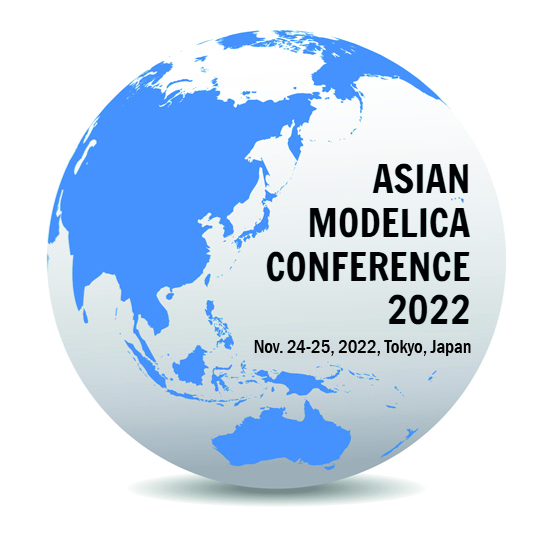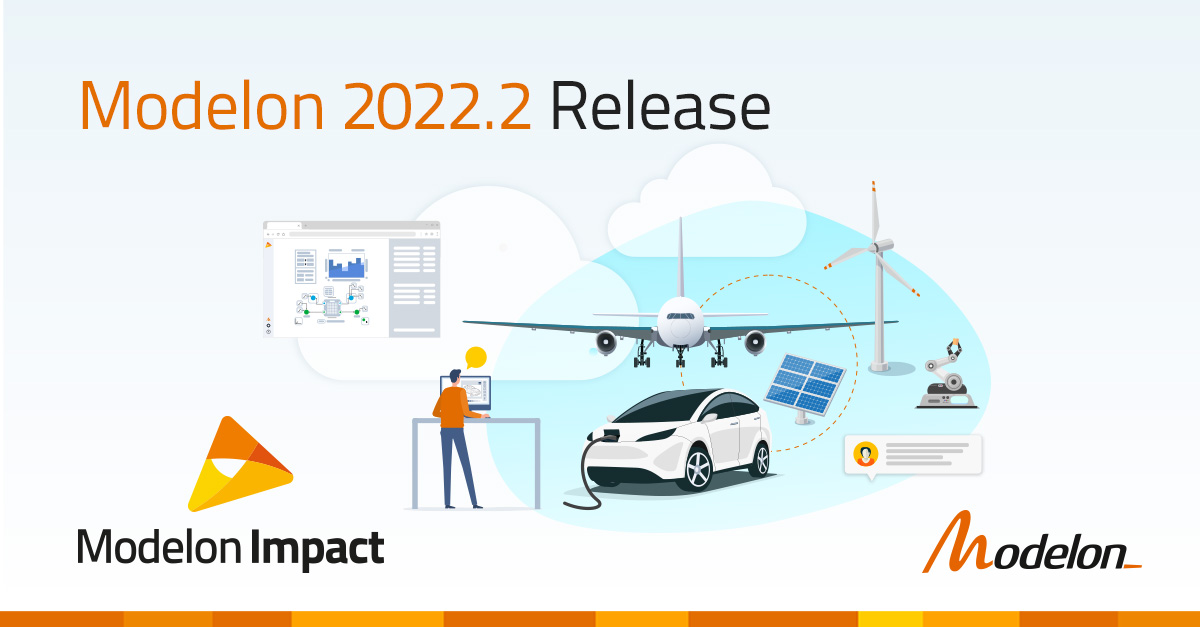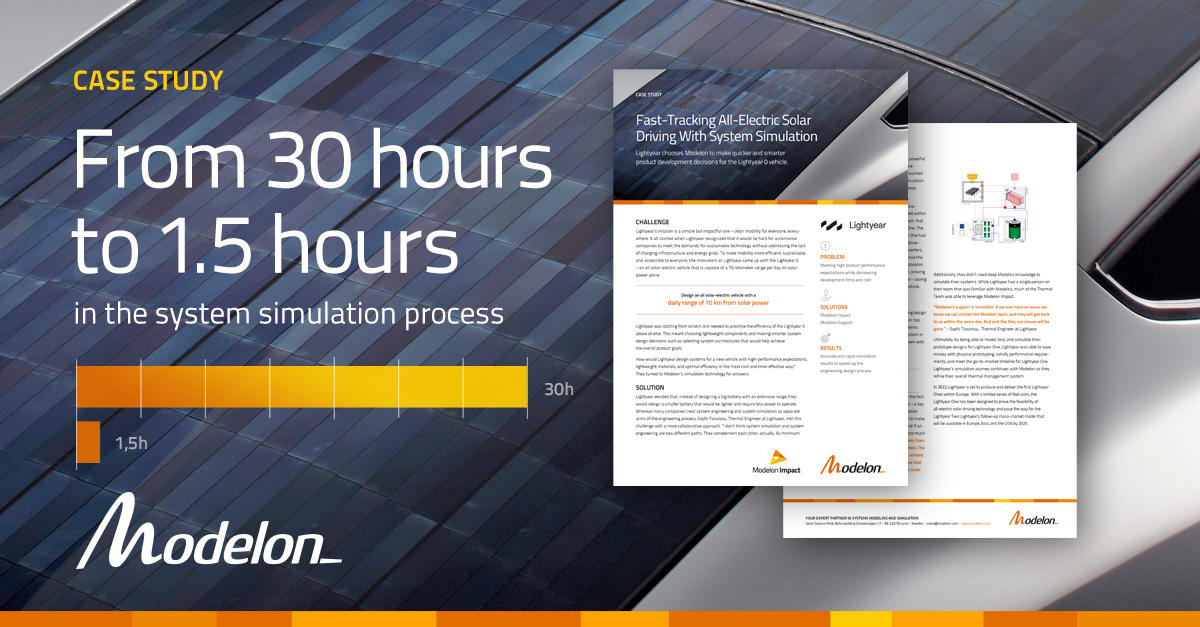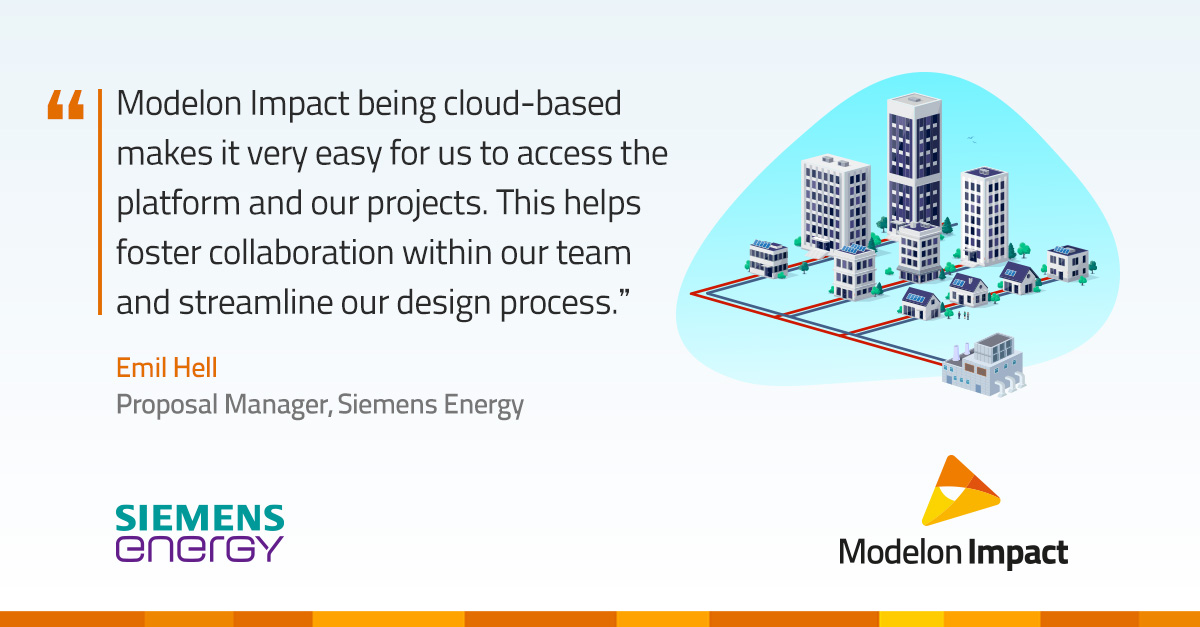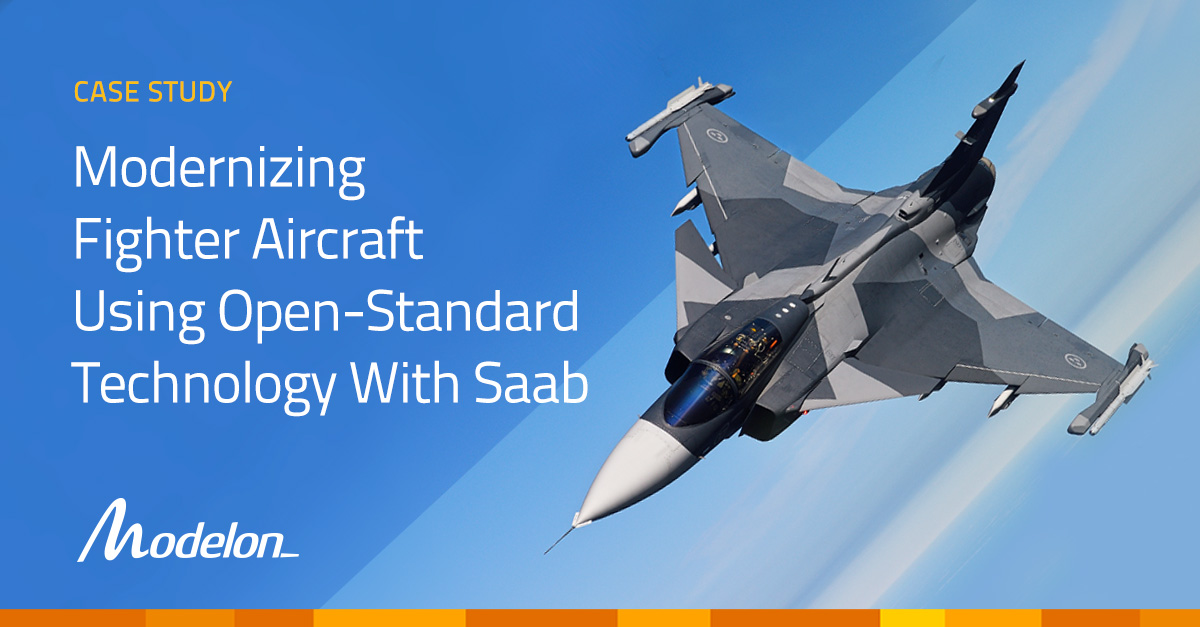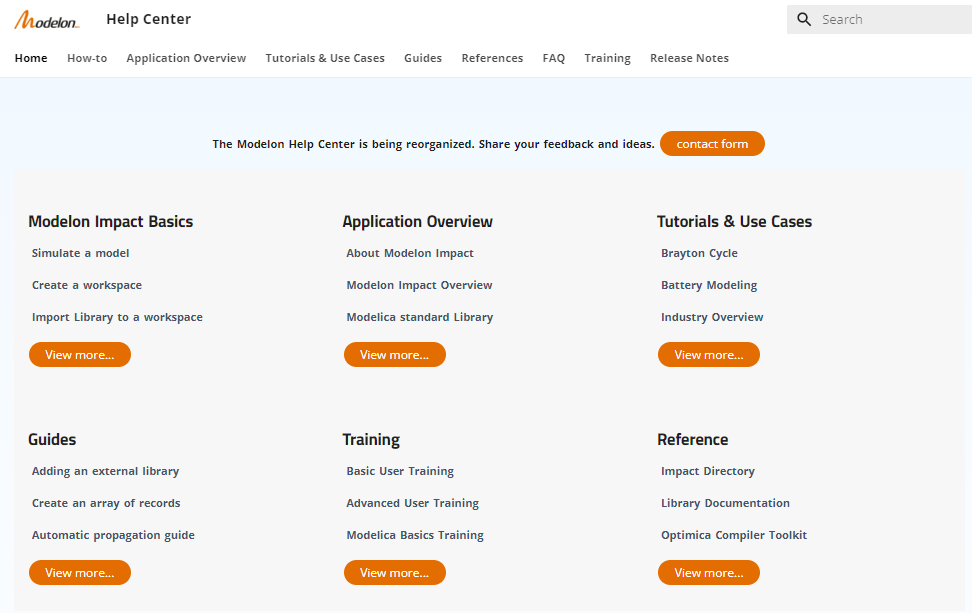Table of contents
- Letter from the Board
- Modelica Association
- Conferences and user meetings
- Vendor news
- News from libraries
- Education news
Letter from the Board
Dear Modelica, FMI, SSP, DCP, eFMI interested,
The Asian Modelica Conference 2022 will take place next week on Thurs. Nov. 24 - Friday Nov. 25, 2022 at Sophia University Tokyo, Japan, as a hybrid conference.
The International Modelica Conference 2023 will take place Mo. Oct. 9 - Wed. Oct. 11, 2023, in Aachen, Germany, as a face-to-face conference. For more details, see article.
At the end of November 2022, a new backwards compatible FMI version 2.0.4 will be released. Most important, this orthogonal release to the other FMI 2.0 features will backport very useful FMI 3.0 features to FMI 2.0:
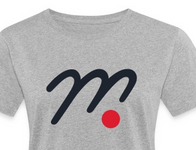
Modelica Association now has a new YouTube channel. There are for example videos of the last Modelica Association conferences and of the Modelica Jubilee Symposium 2019, see playlists.
Modelica Association has now a Spreadshirt Shop where you find T-Shirts, hoodies, coffee cups and stickers with various logos from the Modelica Association and its standards.
If you have interesting news for the Modelica, FMI, SSP, DCP, eFMI communities, please follow the submission guidelines. The deadline for articles for the next newsletter is Friday, March 3, 2023.
Martin Otter on Nov. 21, 2022
Chairperson of the Modelica Association
This article is provided by Martin Otter (Modelica Association)
Modelica Association
15th International Modelica Conference 2023

The 15th International Modelica Conference 2023 will be back in person
Aachen, Germany, Mo. Oct. 9 - Wed. Oct. 11, 2023, so as a face-to-face conference.
It is organized by Prof. Dirk Müller and his team from RWTH Aachen University / Institute for Energy Efficient Buildings and Indoor Climate,
in cooperation with the Modelica Association.
We are excited to have the Modelica Association community back together in an International Modelica Conference since 2019 and have the opportunity to talk in person to each other. The conference will bring together people using Modelica Association standards (Modelica language, FMI, SSP, DCP, eFMI), as well as standard developers/designers, tool vendors, library developers and other interested people. You will have the opportunity to stay informed about the latest standards-, libraries-, and tools-enhancements, and to get in touch with people working on similar challenges as you are doing. As in the past, the conference will be accompanied by tutorials, vendor presentations and an exhibition.
More information will be soon provided on the conference web page, especially, the Call-for-Papers.
This article is provided by Martin Otter (Modelica Association)
Conferences and user meetings
Asian Modelica Conference coming soon
Modelica Conferences are events for users, library developers, tool vendors and language designers to share their knowledge and learn about the latest scientific and industrial progress related to all of the system simulation standards developed and maintained by the Modelica Association, in particular Modelica, the Functional Mockup Interface (FMI), the System Structure and Parameterization (SSP) standard and the The Distributed Co-simulation Protocol (DCP) standard and the Functional Mock-up Interface for embedded systems (eFMI) standard. The program will cover modeling of complex physical and cyber-physical systems, as well as tools, for a wide range of research and industrial applications.
This year’s Asian Modelica Conference is held on November 24-25th and will be a hybrid event, with in-person attendance in Tokyo, Japan. The organizers of this event include the Modelica Association, Sofia University, and Modelon K.K. To register for this event for online or in-person attendance, please visit the conference page.
This article is provided by Kenzie Maurice, Modelon (https://modelon.com)
American Modelica Conference 2022 Summary
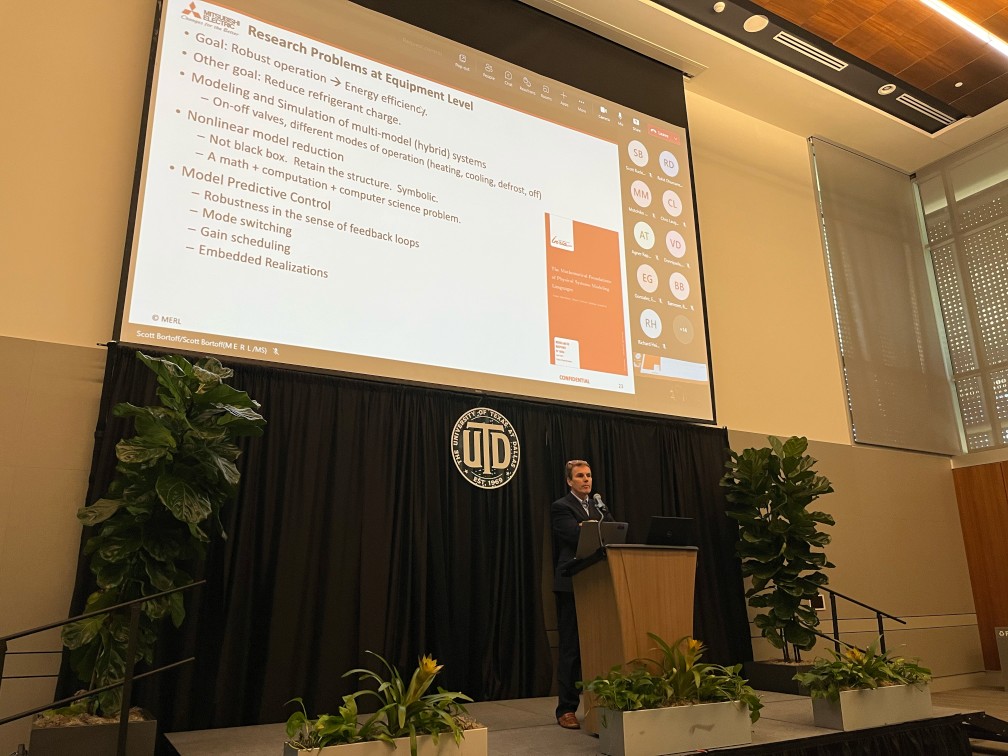
The American Modelica Conference 2022 was held in Richardson, Texas in October. This was our first in-person event since COVID and from all appearances, attendees thoroughly enjoyed the opportunity to get together and discuss their work with Modelica. There were around 60 attendees for this year’s event presenting on a wide range of topics. There were also 42 virtual attendees who joined via the live stream. The conference proceedings are available online here.
Keynotes
This year’s keynote talks were given by Dr. Dirk Zimmer from DLR and Dr. Scott Bortoff from MERL. Special thanks to Scott Bortoff for filling in at the last minute!
Tutorials
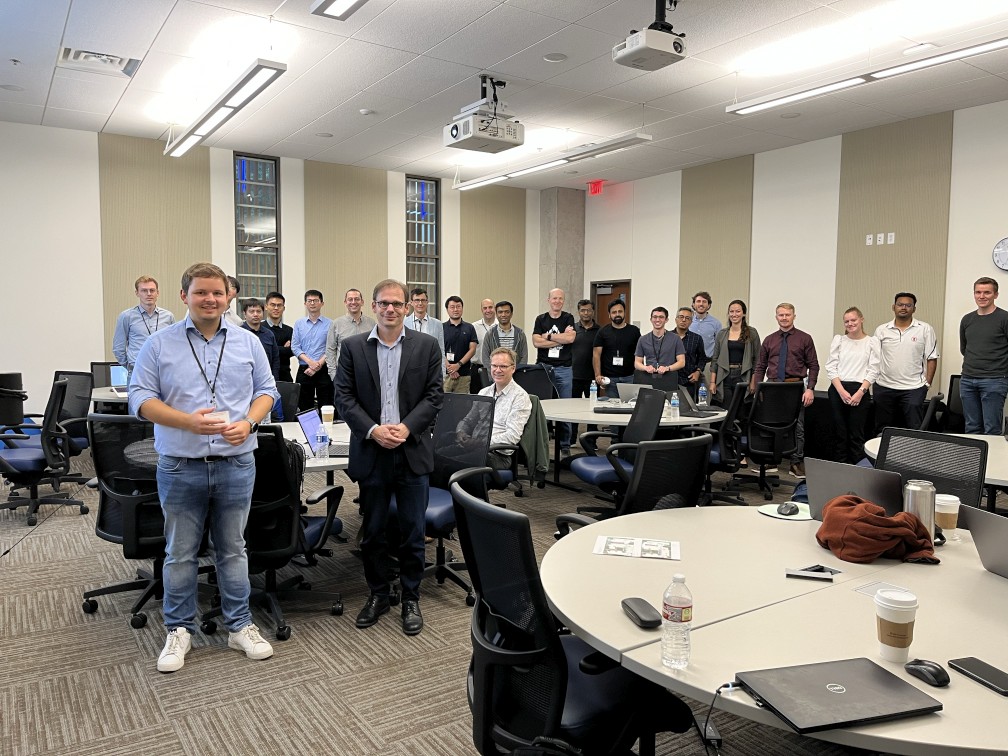
Continuing one of the most cherished traditions of Modelica conferences, this in-person event provided a perfect opportunity to hold a total of six tutorials.
Of special mention, the tutorial from the DLR team on the ThermoFluidStream Library, led by Dr. Dirk Zimmer and Niels Weber, attracted significant attention from conference attendees filling the classroom to capacity!
We would like to thank to all the teams that volunteered offering tutorials for their value contributions that ultimately help building the Modelica community in North America and hope they can continue to do it in future editions of the conference.
Special Thanks
Special thanks to this year’s Platinum Sponsor, Ricardo Software (now Realis Simulation) as well as to our Gold Sponsors, Dassault Systèmes, Modelon, JuliaHub, Wolfram, Ansys and our Silver Sponsor, Maplesoft.
We’d also like to thank Professor Yaoyu Li (University of Texas at Dallas) for all his hard work in providing us with an excellent venue for this year’s event and his students for helping with the execution of the event.
Congratulations
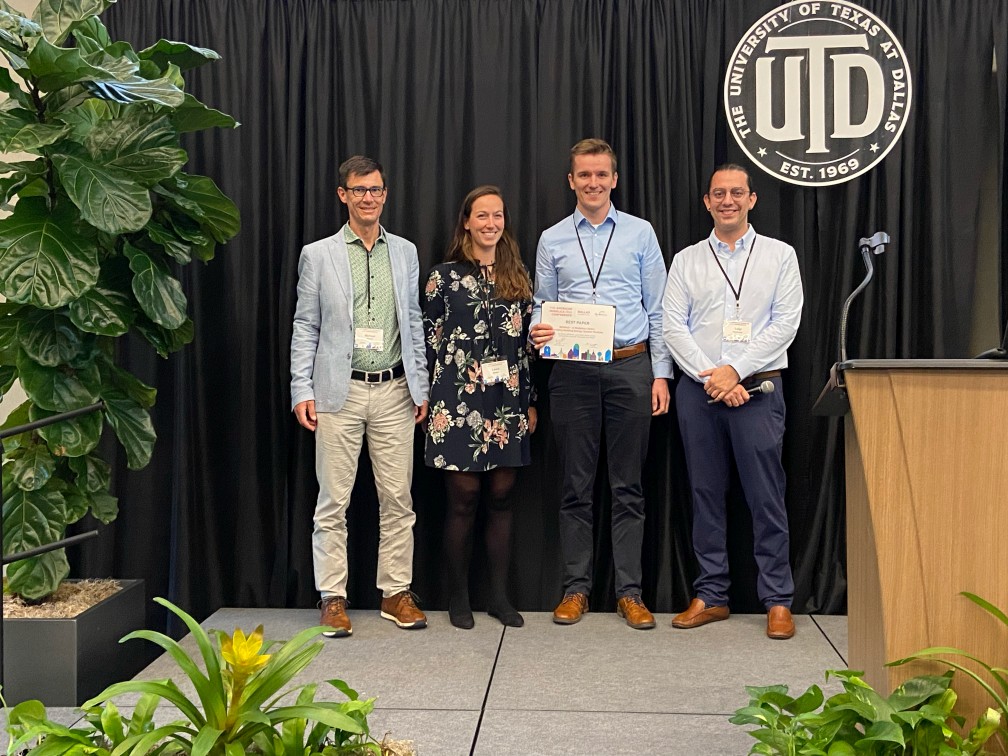
- Best Paper: Congratulations to Fabian Wüllhorst, Laura Maier, David Jansen, Larissa Kühn, Dominik Hering, and Dirk Müller for winning the “Best Paper” award for their paper, “BESMOD – A Modelica Library for Providing Building Energy System Modules”.
- First Runner Up: This award went to Jiacheng Ma, Donghun Kim and James E. Braun for their paper, “Transient Simulation of an Air-source Heat Pump under Cycling of Frosting and Reverse-cycle Defrosting”.
- Second Runner Up: This award went to Hongtao Qiao and Christopher Laughman for their paper, “Performance Enhancements for Zero-Flow Simulation of Vapor Compression Cycles”.
These awards were given based on ratings given by reviewers during the peer review process. We would like to thank the reviewers for their thorough and constructive reviews that were essential in upholding the high quality of the published papers that Modelica conferences are known for. The conference board hopes to continue these paper awards in future conferences, for which we will need the continued support of the Modelica community in reviewing papers.
Future Events
With this event over, we must look now to planning future events. If anyone is interested in hosting the next American Modelica Conference, please contact us. We look forward to seeing you all again in the future.
This article is provided by Michael Tiller
Vendor news
Announcing Dymola 2023x
We are pleased to announce that Dymola 2023x will be available in November 25, 2022.
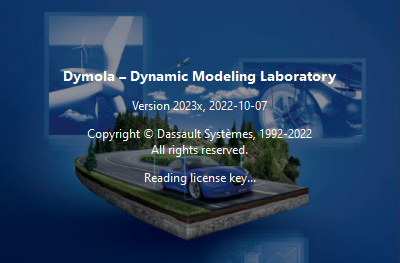
Model editing
It is now possible to view (read-only) libraries and your own files in separate browsers. This makes the separation clear, and you can arrange the browsers around your Dymola window to fit your workflow. The traditional view is the initial default.
The handling of external resources associated with a model, such as, images in the documentation or data tables on file, has been improved. This means that when moving or copying a model the resources are copied to the same relative location.
Simulation
Commands that perform multiple simulation can change any parameter, lifting the earlier restriction that evaluated parameters cannot be changed. However, changing a structural parameter will of course add the overhead of translating the model.
Model import and export
Dymola 2023x is the first release to support the much-awaited FMI 3.0 file format that is expected to gain wide acceptance. New features of FMI 3 (arrays, ports and terminals, early return to handle events) will be supported in the near future.
SSP import supports Simulation Resource Meta Data (SRMD) stored in the SSP file. The meta data has been proposed to facilitate a credible simulation process with an adaptable format.
This article is provided by Dag Brück (Dassault Systemes)
Spread your knowledge with FMU based engineering webapps for everyone
Simcenter Webapp Server is a web-based tool that enables you to create engineering webapps in your company. As a model owner it’s an easy and safe way to spread your knowledge because you can grant the usage of this model through a customized webapp to anyone you give access. There are numerous applications where this can be of high value. Think for example about your presales/sales colleagues throughout the world who need tools for proof the performance of your products in front of their customers.
Since release 2022.1 it is possible to create engineering webapps from a Functional Model Unit (FMU) created with other authoring tools such as:
- Other system simulation tools like Simcenter Flomaster
- 3D simulation tools, such as Simcenter Star-CCM+
- The Simcenter ROM builder that creates an FMU based on your model or experimental results
- All third-party tools that can create a tool independent co-simulation FMU according to the FMI 2.0 standard.
The value of knowledge is in accessibility
The time and knowledge you’ve invested in creating your models is of high value, not everybody can do the same and many important decisions rely on them. Many of your colleagues or other connections would be glad to leverage your expertise even if they’re not an engineer themselves. With Simcenter Webapp Server you can spread your knowledge and support them with easy and safe access, which means:
- No tool installation for end-users, the engineering webapps are available within a web browser.
- You can make sure that everyone is using the right version of the webapp and the FMU at any time, no versioning headache anymore.
- It protects your IP. Since you centralize all simulations on a server there’s no direct access to model IP.
- You control the permissions and can manage user access at every moment.
How to create an engineering webapp from my models? The Simcenter Webapp Server is an easy to deploy and easy to use tool, these few steps show how to create your engineering webapps.
For more information on Simcenter Amesim, please visit our website.
This article is provided by Romain Gonard (Siemens Digital Industries Software)
Upcoming - System Modeler 13.2!
System Modeler 13.2 will be releasing soon.
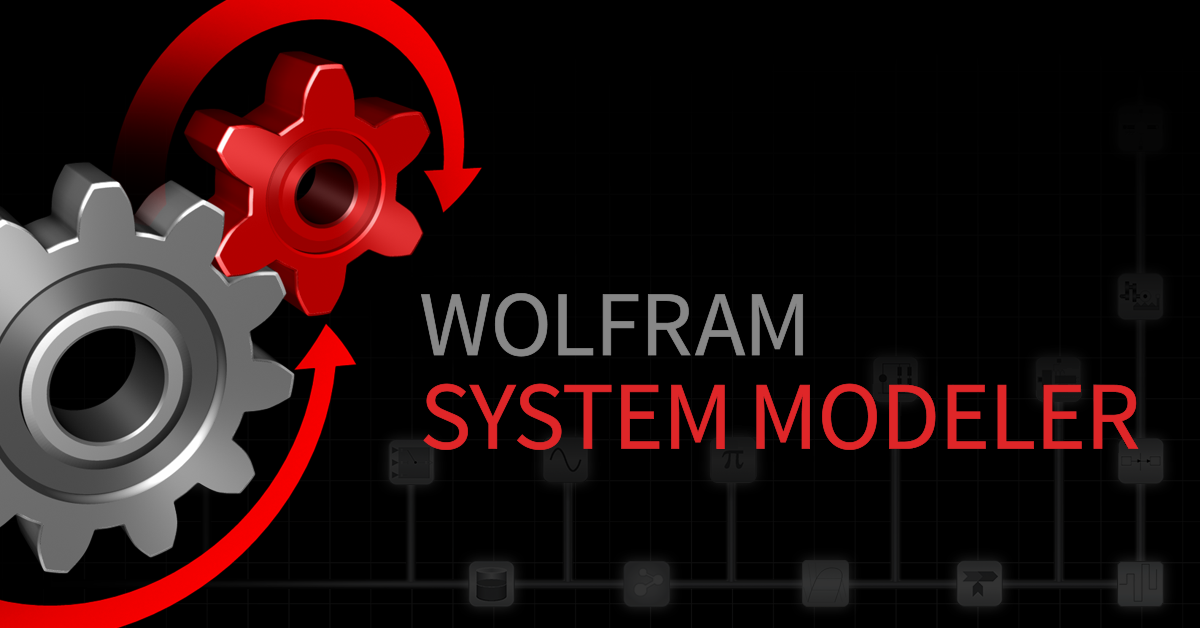
The upcoming version of System Modeler contains many new features. Some of the significant features are:
- Interactively Explore Simulation Results: Explore model behavior interactively using sliders, popup menus, and checkboxes.
- Helpful & Precise Model Validation: Precisely detect errors using improved error messages and warnings that link directly to the relevant line of code.
- Quantify System Performance: Automatically measure the performance and quality of a system with properties such as rise time, settling time, overshoot, and more.
- Free Aircraft Library: Decrease design for new aircraft using novel weight estimation method. Use ready-made digital twins of existing conventional aircraft or create your own by parametrization.
- Free Rotating Machinery Library: Model and analyze rotating machinery systems, such as turbines, motors, and drivelines. Easily create digital twins of roller bearings from SKF, Timken, Koyo, and more, and analyze deformations and contact pressures.
Click here to read the latest System Modeler news.
This article is provided by Ankit Naik Wolfram
Simcenter Amesim 2210
Siemens Digital Industries Software is proud to announce the recent release of Simcenter Amesim 2210, as part of its system simulation solutions. Among the key features introduced in this release, we can highlight the Modelica Editor related improvements and the FMI improvements below.
Simcenter Amesim offers a full-featured editor for the Modelica language that enables using and maintaining Modelica legacy code and building your own Modelica-based models. Thus this complete integrated development application, the Modelica Editor, creates bridges between the acausal world of Modelica and the causal environment of Simcenter Amesim.
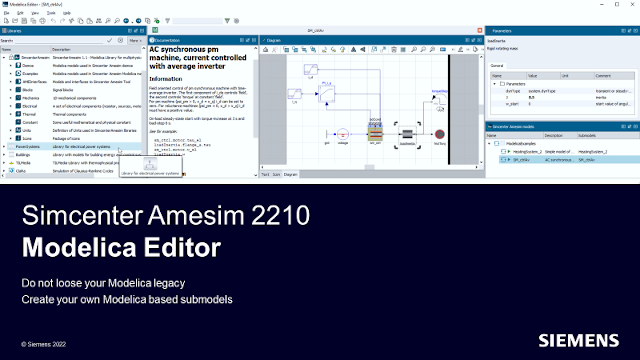
Automatic generation of iteration variables and their guess values
As of Simcenter Amesim 2210, the Modelica editor provides a new toolbar button allowing to automatically generate the iteration variables of a selected model during compilation. As shown in the following figure, the iteration variables are defined in a record and automatically added to the model code to be reused directly from the Simcenter Amesim parameters panel.
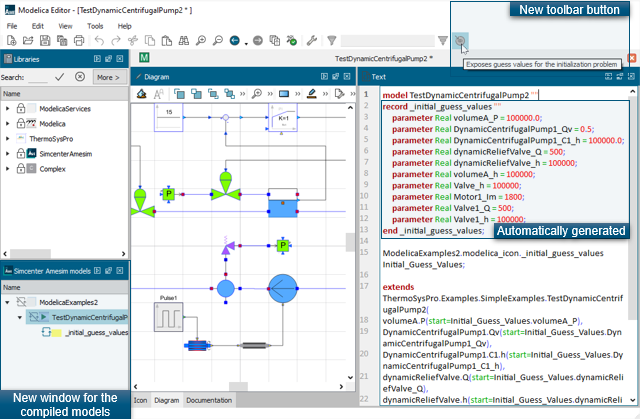
Modelica Editor’s new capabilities
The latest version of Modelica Editor contains other new features, the most important of which are:
- A new option now available in the Modelica preferences, enabling parameter evaluation as a means to reduce significantly the simulation time.
- A dedicated widget for your already-compiled models that are now seperated from your library tree, as shown in the figure above.
- An easy update of your Modelica models directly in the Modelica Editor and a faster troubleshooting.
- An active tab now linked to its Modelica class highlighted in the library tree.
- Non-Latin (UTF-8) characters, like Asian characters, are now fully supported in Modelica descriptions and reflected without any changes once in Simcenter Amesim.
FMI improvements
- Leveraging Windows to Linux cross-compilation using FMI With Simcenter Amesim 2210, you can create and share components with Linux users directly, from a 100% Windows ecosystem, without revealing any source code. More details
- Direct export, from Windows, of FMUs usable under Linux 64-bit
- Improved workflow for FMI based Linux 64-bit real-time targets
- Support of NI Linux Real Time OS (Intel x64) via FMI
- Export of FMUs via a dedicated Python script A new Python script allows exporting FMUs “offline” i.e., without having to open the Simcenter Amesim GUI. More details
- Improved support of units and non-Latin titles For an improved handling of exported FMUs, the units are now automatically declared and converted to the International System of Units. More details
- Towards FMI 3.0 In addition to the “FMI terminals” feature, already supported by Simcenter Amesim and Simcenter Flomaster, Siemens Digital Industries Software plans to implement the support of FMI 3.0 in the forthcoming releases of its system simulation solutions. Stay tuned!
For more information on Simcenter Amesim improvements, please check this blog post. For more information on Simcenter Amesim in general, please visit our website.
This article is provided by Karim Besbes and Bruno Loyer (Siemens Digital Industries Software
Modelon Updates

Modelon is revolutionizing the engineering design industry by offering technologies and services that enable customers to leverage system simulation. Modelon’s flagship product, Modelon Impact, is a cloud system simulation platform that helps engineers virtually design, analyze, and simulate physical systems.
Visit https://modelon.com for more information.
Follow us on LinkedIn.
Modelon Impact 2022.2 Release Now Available
We’re happy to announce one of our biggest releases – Modelon Impact Cloud, our system simulation platform accessible via public cloud. Read the full release announcement here. Watch the Modelon Impact explainer video here.
Modelon Case Studies
Lightyear and Modelon: Fast-Tracking All-Electric Solar Driving With System Simulation
Time is valuable, especially for a company such as Lightyear to build and bring to market a cutting-edge solar-electric vehicle. With Modelon Impact, Lightyear reduced its overall system design and simulation time while making smarter development decisions along the way. Read the case study.
Siemens Energy and Modelon: Adapting to the Future of Energy Technology with System Simulation
Siemens Energy needed to improve and further develop its heat pumps to ensure the performance and design of the integrated systems worked efficiently before moving forward with deployment. In our new case study, learn how Siemens Energy integrated its advanced energy systems with its existing heat pump technology using Modelon Impact. Read the case study.
Saab and Modelon: Modernizing Fighter Aircraft with Open-Standard Technology
In 1988, Saab made history with the Gripen - the first multirole fighter aircraft developed in Sweden to take flight. Since its initial development, Saab has been tasked with making iterations of the Gripen, which are each more powerful and technologically advanced than before.
This case study explains how Saab worked with Modelon to incorporate MBSE and greatly enhance the Gripen without overextending its in-house resources. Read the case study.
New Training Content in Modelon Help Center
The Modelon Help Center is a public resource for Modelon Impact users, simulation and modeling professionals, Modelica modelers, and students to leverage the expertise that Modelon’s experts have to offer. Access guides and material for Modelon Impact and Modelon libraries within the energy & process, automotive, aerospace, and industrial equipment industries.
We’ve now released training material from our most recent global conference, Modelon Innovate. From learning how to use advanced workflows to simulating industry-specific applications, Modelon Help Center users can now access all the latest content from the conference.
Blogs
Trends in Energy Technology for 2022
This blog describes the trends and observations of innovative energy technologies in 2022 and beyond. With over 20 years of experience in model-based engineering, Modelon’s Energy and Process Industry Director, Stéphane Velut, shares his views on energy technologies trends, observations & insights – with a focus on what he is seeing in the industry and how simulation software is enabling world-leading organizations to get ahead. Read the blog.
What is Physical System Simulation?
Physical system simulation is an elusive concept –yet on your journey to virtualize the product design process, there is no way around it. In the first blog of the Success with Simulation series, PieterDermont, Modelon’s Senior Business Development Director, covers what physical system simulation is, what it is not (hint, it is not “systems engineering”), and what it can do for your organization. Read the blog.
Hybrid Electric Propulsion Systems: Modeling the Backbone of Electric Aircraft
Part one of the Sustainable Aviation Blog Series. Developing technologies to enable more sustainable aviation for the aerospace industry is a crucial challenge that engineers are trying to overcome. This blog focuses on modeling and simulating fuel savings and increased flight range which is powered by hybrid electric propulsion systems. Read the blog.
Direct Air Capture: Seizing Emissions to Achieve Climate Targets
Direct Air Capture (DAC) is a technology that captures and scrubs carbon dioxide from the atmosphere. In this blog, learn the DAC process step-by-step and how this technology can be integrated into current systems by simulating prebuilt model examples in Modelon Impact. Read the blog.
This article is provided by Kenzie Maurice, Modelon (https://modelon.com)
News from libraries
MultiflashMedia connector library
The MultiflashMedia connector library was initially released with Dymola 2022x. With Dymola 2023x, it has been updated to version 1.1.1. The library is an interface to the external multi-component, multi-phase fluid property models and solvers of the Multiflash software package by KBC.
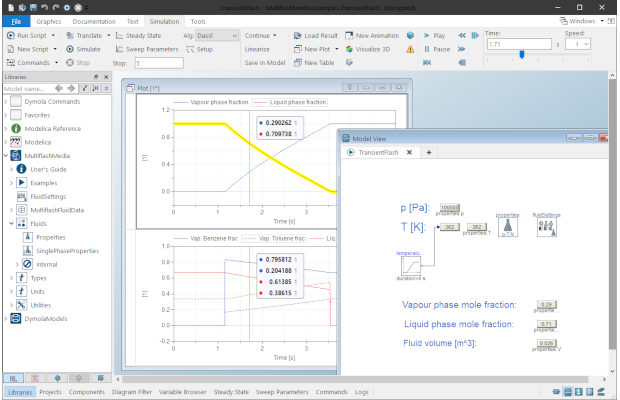
The library implements an object-oriented approach to the medium model. The interface to Multiflash is provided in the form of the Properties-class. Its instantiation in a Modelica component or system model is mirrored by a Modelica External object. The external object handles the communication with the Multiflash software. Among the supported flash calculation input variable sets are p,T,N-, p,h,N-, U,V,N-, as well as fixed-phase p,X,N- flashes. The library supports the thread-safe API features of the Multiflash software and is suitable for simulation on multiple cores in Dymola.
The fluid configuration is file-based, using Multiflash Command File syntax and file format. For Modelica models that require fluid properties for more than one single mixture, the configuration of multiple mixtures with distinct components, phases and models within a single command file is supported.
This article is provided by Philip Jordan (Dassault Systemes Deutschland GmbH)
Testing Library 1.6.0
The Testing library allows to create test models graphically and run them in Dymola. All libraries developed by Dassault Systèmes are using it to test several hundreds of test models with thousands of test cases.

The latest Testing version v1.6.0 is available with Dymola 2023x and it remarkably improved the creation of reference results.
-
New file formats: In addition to the previously supported .sdf format users can now also record their references into .mat and .txt files (used my MSL’s CombiTimeTable). Switching between formats is easy: Just change the extension in the path to the reference file and record new references. No model changes are needed.
-
Clean results: The burden of manually deleting unwanted trajectories form the recorded reference has now been eliminated. Unnecessary trajectories are automatically removed, so no manual steps are needed anymore (in previous version one had to cleanup the files with the SDF Editor).
-
Trajectory filtering: Constant segments in recorded trajectories can be filtered. This can dramatically decrease the file size.
We encourage you to try out the latest version now, which is available with the standard Dymola license. To get started, read the User’s Guide of the library or check out this blog post by Claytex.
This article is provided by Marco Keßler (Dassault Systèmes Austria GmbH)
Education news
Free Interactive Animations for your College Mechanical Engineering Classes
Learn and teach mechanics courses using the labs from the College Mechanical Engineering library. Simulate things such as a stunt jump, camera stabilization system, and washing machine to understand mechanical engineering concepts, including coordinate transformation, kinematics, and dynamics. You will also learn to create and test models with 3D animations.

Download the library from the System Modeler library store here.
This article is provided by Ankit Naik Wolfram
Claytex technical blog

Claytex publishes a technical blog covering all things Modelica and Dymola.
Major Updates to the UAVDynamics Library
Following a very successful Innovate UK – Future Flight project, the library has been significantly changed to accommodate the extra capabilities.

Read the complete article here
Basic Dymola Terminology
Like anything technical, there’s plenty of jargon surrounding Dymola and its functionality. While much of it is relatively self-explanatory, some may not be clear at first glance. In this blog post we try to shed some light on basic Dymola terminology, and provide a few details on their application in the world of Dymola.

Read the complete article here
DTM in the 90s: Modelling Mercedes-Benz’s active ballast system
Evolving out of the ferociously popular German DTM series in the mid 1990s, the International Touring Car Championship (ITC) featured exotic and sophisticated racing cars; certainly, the most advanced production-based racing cars ever seen. Packed with various gizmos and technologies, we thought it would be a fun exercise in simple multibody modelling to build some of the famous features of these machines.

Read the complete article here
Dymola Workshop – Available to View on Demand
Get an overview of systems modelling and how to set up a virtual testing process to assess and develop your products faster and more sustainably.

Learn more and watch On Demand here
This article is provided by Mahdieh Mehrabi (Claytex)
